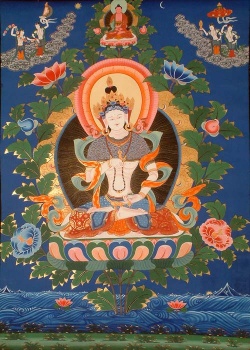Maha Kotthita
One of the foremost disciples of the Buddha, ranked foremost among masters of logical analysis (patisambhidappattanam) (A.i.24; Dpv.iv.5; v. 9). He was born into a very wealthy brahmin family of Savatthi, his father being Assalayana and his mother Candavati.
He gained great proficiency in the Vedas and, after hearing the Buddha preach (to his father, says the Apadana account), entered the Order and, engaging in meditation, soon became an arahant.
He was extremely skilled in knowledge of the Patisambhida, on which were based all his questions to the Buddha and his own colleagues.
In the time of Padumuttara Buddha he was a rich householder, and, hearing the Buddha praise a monk as foremost among those skilled in the Patisambhida, he wished for similar eminence for himself in the future. To this end he visited the Buddha and his monks and entertained them for seven days, giving them three robes each at the conclusion of his almsgiving. Owing to the skill showed by him in the Maha Veddha Sutta (q.v.), the Buddha declared him foremost among those skilled in the Patisambhida (Thag.vs.2; ThagA.i.29ff.; AA.i.159; Ap.ii.479; also Avadanas ii.195).
Several instances are given of discussions between Kotthita and other eminent theras - e.g., the Nalakalapiya Sutta on kamma (S.ii.112f), the Sila Sutta on religious discipline (S.iii.165ff), three suttas on samudayadhamma (the nature of arising), two on assada (satisfaction) (S.iii.172-7), two on samudaya (arising) (S.iii.173) and three on avijja and vijja (S.iii.17). Another similar sutta is on sense and sense objects (S.iv.162-5), and there is a series of suttas on matters not revealed by the Buddha (avyakatani). S.iv.384-91; Mrs. Rhys Davids suggests (KS.i.79i n.1) that all these suttas were compiled rather as lessons to be learnt than as genuine inquiries by Kotthita. The pre eminent monks were playing at teacher and pupil in order to aid Kotthita to win proficiency as a teacher. Another such lesson is given at A.iv.382ff., as to the motives guiding those who live the brahmacariya life.
All these suttas took the form of discussions with Sariputta, in which Maha Kotthita is the questioner and Sariputta the instructor.
One sutta (S.iv.145 7) records a lesson given by the Buddha to Kotthita on conceptions of anicca, dukkha and anatta. The Anguttara Nikaya (see the Kayasakkhi Sutta, A.i.118f) records a discussion at Jetavana between Savittha, Kotthita and Sariputta, as to who is best: one who has testified to the truth with body, one who has won view, or one released by faith. Another discussion (A.ii.161f) takes place between Sariputta and Kotthita as to whether anything continues to exist after the ending of the six spheres of contact (Nibbana). Once there was a dispute between Kotthita and Citta Hatthisariputta;
